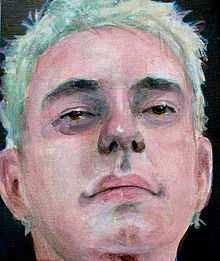Steve Cox (artist)
| Steve Cox | |
|---|---|
| Born |
Steven Martin Cox 1958 Harringay, London, England |
| Nationality | Australian |
| Education | Victorian College of the Arts |
| Known for | Predominantly watercolour, gouache, collage on paper. |
Steve Cox (born 1958) is an Australian painter and watercolour artist known for his psychologically penetrating images of youths and young men; stream of consciousness landscapes and animal/human hybrids.
Early life and education
Cox was born in Harringay, London, England and arrived in Melbourne, Australia in 1967, when his family emigrated. He studied painting at the Victorian College of the Arts from 1978 to 1980. In 1983 he was awarded the Keith & Elisabeth Murdoch Travelling Fellowship and subsequently spent eighteen months making work in London and Cairo. The same year he was awarded an Australia Council grant to spend three months making work at the Villa Ghedini, in Besozzo, Northern Italy. Also in 1983, he was included in the important survey of Australian art, Perspecta, at the Art Gallery of New South Wales.[1]
Cox is currently completing a PhD in Art History at Monash University on the suppression of homoeroticism in western art since the Renaissance and the ways in which artists have managed to circumvent this censure.
Career
His early work dealt with the aberrant psychology of murderers and their victims. In 1987 he staged an exhibition of paintings about the 1960s British Moors murderers. Cox has also painted pictures of serial killers Dennis Nilsen and Peter Manuel. In 1995, his exhibition Kinderspiel (Child’s Play) dealt exclusively with the subject of children who kill other children.[2][3] His 1996 Masters Thesis (Deakin University), titled ‘Murder and Art: the Causal Links’, drew parallels between the creative mind of the artist and the murderous mind of the serial killer.
More recently, Steve Cox's work has explored the phenomena of dance culture; this subject has spawned five exhibitions of portraits of clubbers, drug takers and bouncers, most notably in Rave: Club Culture (2000), Ecstasy: a celebration (2000)[4] and Confessions of a Raving Lunatic (2002).
As a gay artist, Cox has often featured homoeroticism within his work. His exhibition Testosterone Zone (1996) dealt with, amongst other things, frank male nudity and the still-existing taboo over public representations of male genitalia. To this end, he has always been outspoken against censorship in the arts, as seen in an interview in issue 11 of Artist Profile magazine (2010).[5]
For decades, Cox's imagery has often been surreal, using unsettling juxtapositions of symbols. In The New Agrarian (1991), a partially nude boxer spars alone in front of a blackboard in an otherwise empty field. In Jelly Kitten (2005) a cartoon cat's head is simultaneously a portrait of a cute children's cartoon character and a tormented mind, much like Sidney Nolan's Gallipoli series, which featured portraits of returned soldiers.
Exhibitions

Since 1982 he has held over thirty one-person exhibitions in Melbourne, Sydney and Adelaide, and has participated in over forty group-exhibitions, including Moist: Australian Watercolours, (2005) at the National Gallery of Australia, Canberra,[6] and This and Other Worlds, (2005) at the National Gallery of Victoria, Melbourne.[7] In 2008 he was included in True Crime: Murder and Misdemeanour in Australian Art, at the Geelong Art Gallery.[8]
Between 2008 and 2012 Cox set up the Steve Cox Prize for Drawing at the Victorian College of the Arts.
Cox's work is held in The National Gallery of Australia, The National Gallery of Victoria and other important public and private collections throughout Australia. His work has been featured in Nevill Drury's New Art series of books and Sonia Payes' Untitled, a book of photographic portraits of contemporary Australian artists.[9][10]
Personal life
He has two children, Eden Fabienne Cox (born 1986) and Hadrian Valentine Cox (born 1989). In October 2009 he was diagnosed with non-Hodgkin lymphoma.[11] As of February 2010 he is in remission.
In April 2011, Cox was the defendant in the first Facebook stalking lawsuit in Australia, which was instigated by the Head of School of his then employer, RMIT University. In what Cox termed a 'clear victory for freedom of speech', the case was thrown out of court.[12]
Collections
- National Gallery of Australia, Canberra, ACT
- National Gallery of Victoria, Melbourne
- Ian Potter Centre, Melbourne
- La Trobe University Collection, Melbourne
- Mornington Peninsula Regional Gallery, VIC
- Victorian College of the Arts, Melbourne
- Benalla Art Gallery
- The Estate of Reggie Kray
- The Estate of Francis Bacon
See also
- Visual arts of Australia
References
- ↑ Perspecta catalogue, Art Gallery of New South Wales, 1983
- ↑ Cox Jettisons Obsession to Find Compassion, Gary Catalano, The Age, 5.24.89
- ↑ Child's Play, Colin Shingleton, Art Monthly, April 1995
- ↑ Method in the Madness, Peter Timms, The Age, 4.12.00
- ↑ Flynn, Paul (2010). "Steve Cox". Artist Profile (11): 76–81.
- ↑ Moist: Australian Watercolours catalogue, National Gallery of Australia, Canberra, 2005
- ↑ This and Other Worlds catalogue, National Gallery of Victoria, 2005
- ↑ True Crime: Murder and Misdemeanour in Australian Art catalogue, Geelong Art Gallery, 2008.
- ↑ Images in Contemporary Australian Painting, Neville Drury, Craftsman House, 1992
- ↑ Untitled: Portraits of Australian Artists, Sonia Payes, Macmillan, 2007
- ↑ Artist Profile magazine, issue 11, 2010, pp 76 -81.
- ↑ Quinn, Karl (14 April 2011). "Art school altercation puts new spin on cyberstalking". The Age (Melbourne). Retrieved April 14, 2011.
- Young Australians catalogue, National Gallery of Victoria, 1987
- "Contemporary Voices: Steven Cox", Roger Taylor, Asian Art News, Vol 5 No.3, May/June, 1995
- "A Bleak Outlook Isn't Always Bad", Robert Rooney, The Australian, 5.16.89
- "The Misadventures of Cap'n Kirk", Robert Rooney, Weekend Australian, 5.20.89
- "Face to Face With Childhood's Darkest Side", Robert Rooney, The Australian, 1.29.94
- "Another Walk on the Wild Side", Adam Dutkiewicz, The Adelaide Avertiser, 6.4.97
- "Sex, Violence and All Things Underneath", Peter Timms, The Age, 3.10.99
- Artist Profile magazine, issue 11, 2010